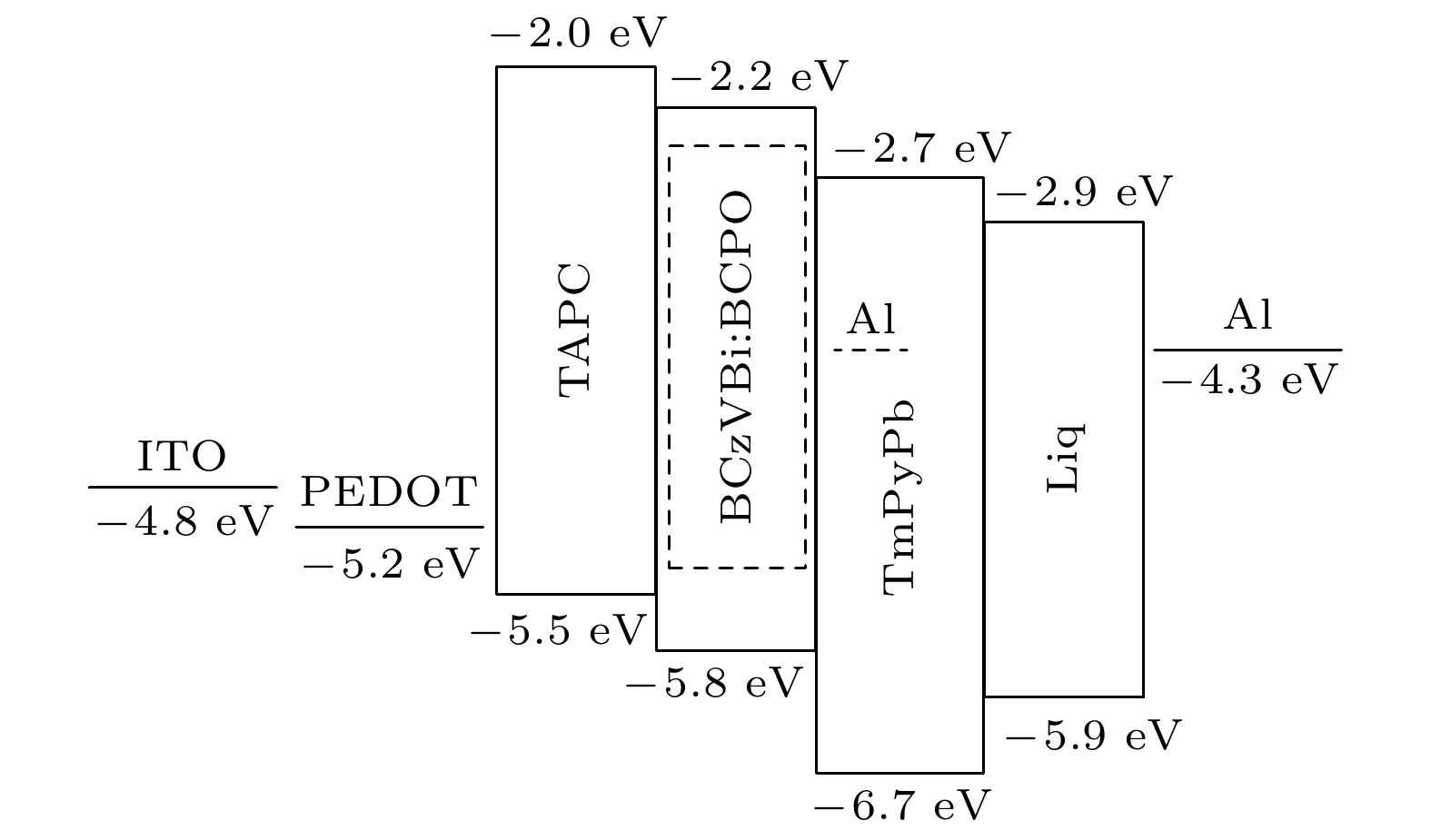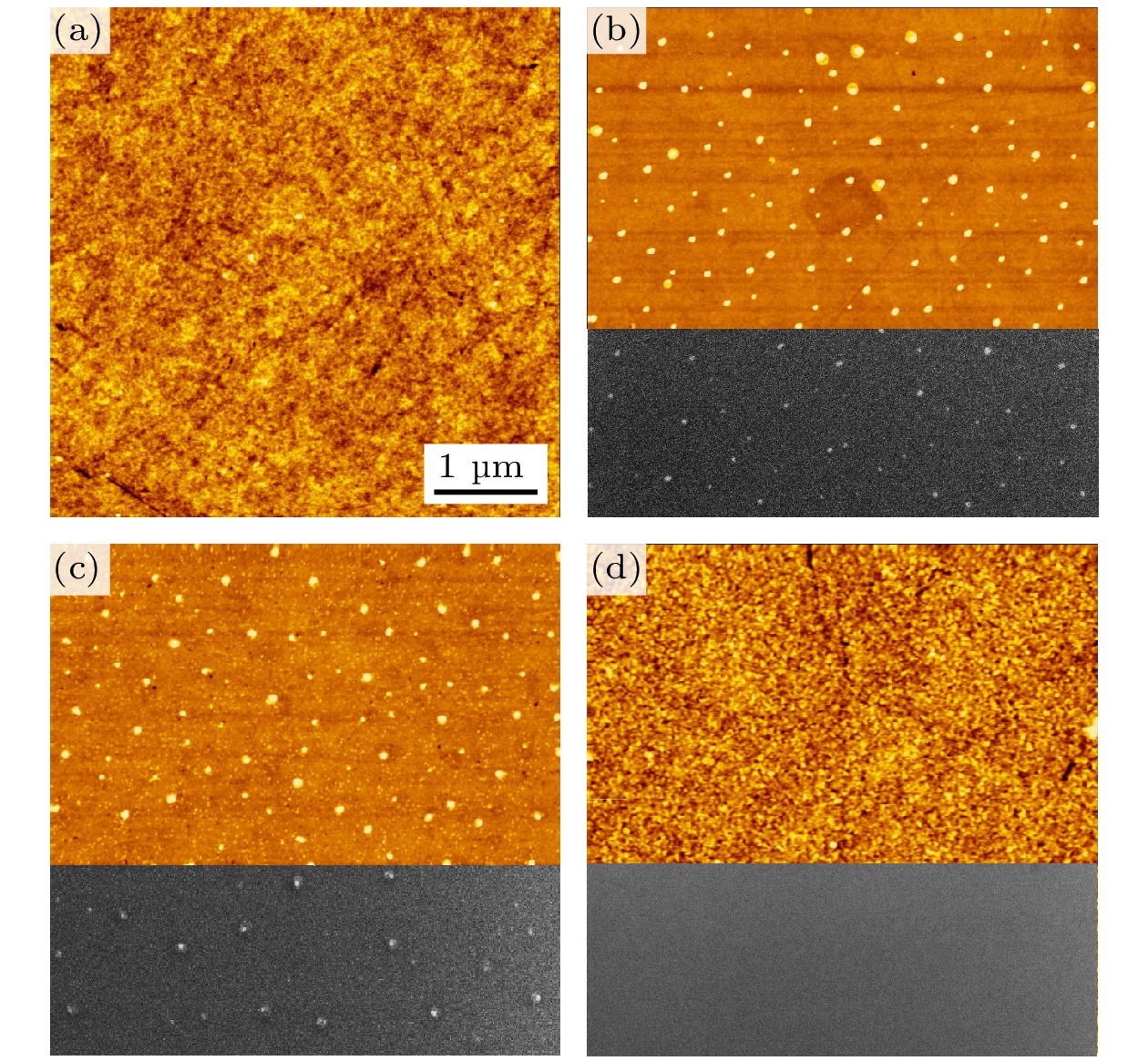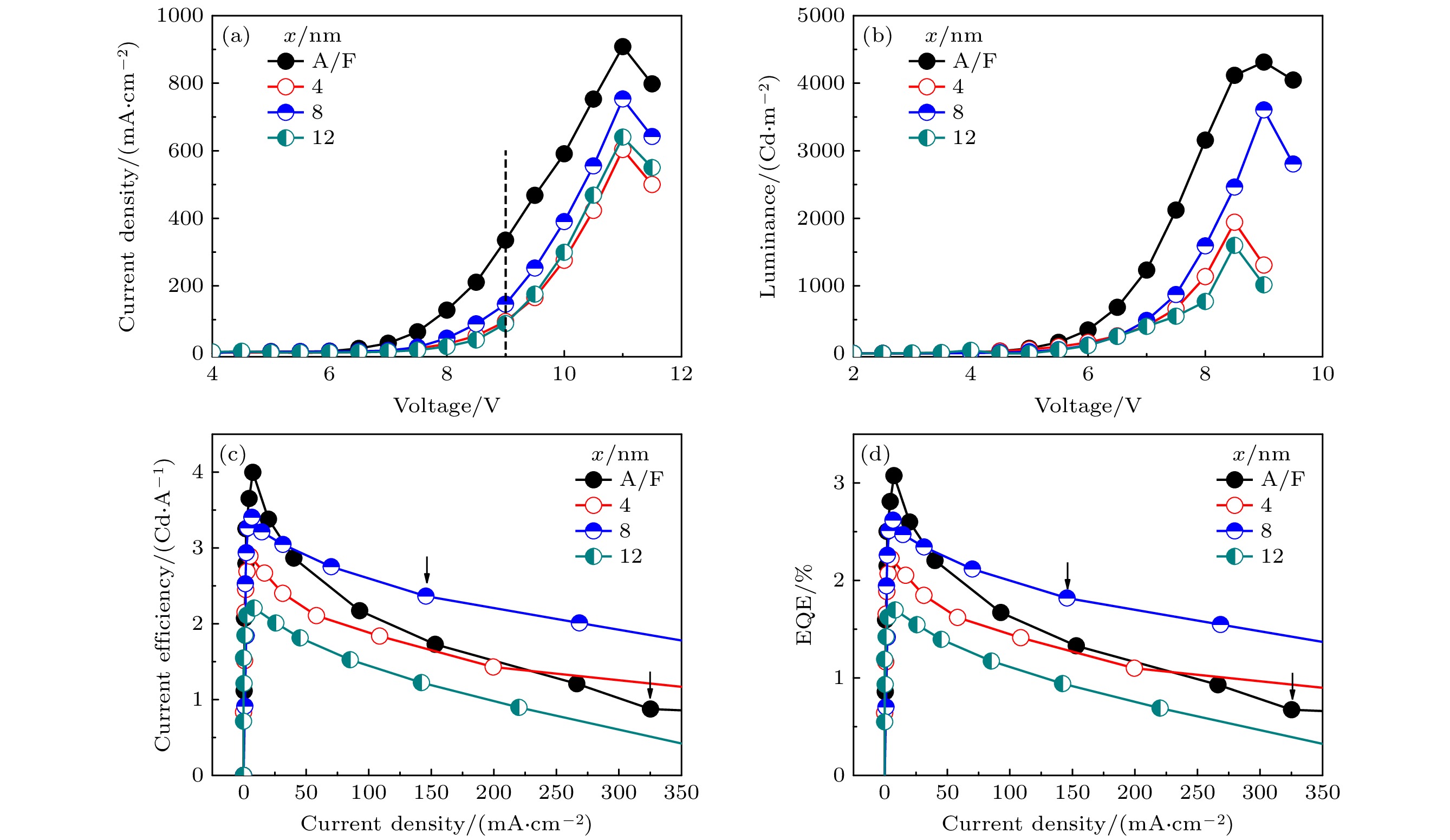-
蓝紫光有机电致发光器件难以提升发光效率. 本文以BCzVBi作为深蓝荧光材料, 把Al纳米颗粒引入ITO/PEDOT:PSS/TAPC/BCzVBi:BCPO/TmPyPb/Liq/Al有机发光器件的TmPyPb电子传输层, 尝试用Al纳米颗粒的高频局域等离激元效应来改善此问题. 在室温真空蒸镀Al膜, 厚度为1 nm时, 形成尺寸在10 nm量级的分散纳米颗粒. 将这种颗粒膜插入TmPyPb层内距离BCzVBi:BCPO发光层x = 4, 8, 12 nm处, 与没有Al层的对比器件相比, 器件的电流密度和发光亮度都会因载流子迁移率变差而下降. 但在x = 8 nm, 两者都显著回升. 其机理可能在于, x < 8 nm, 会产生过强的荧光淬灭, 而x > 8 nm, 到达Al颗粒的荧光衰减过多, 又难以产生足够强的局域等离子体振荡. 在x = 8 nm, 达到最大亮度的电压(9 V)没有变化, 最大亮度从4200 Cd/m2降到3500 Cd/m2, 但电流密度也从335.19 mA/cm2减小到145.71 mA/cm2, 使得电流效率反而从0.88 Cd/A提高到2.36 Cd/A, 从而把外量子效率提升了170%, 效率滚降比则从78%降到30.5%, 压减61%. 在电流密度高达270 mA/cm2时, 电流效率和外量子效率也能提升66.5%. 这些结果表明, Al纳米颗粒高频局域表面等离激元确实能够有效增强深蓝光有机发光二极管的发光性能.
-
关键词:
- 深蓝荧光有机发光器件 /
- 局域等离激元效应 /
- Al纳米颗粒 /
- 发光效率
It is difficult to enhance the blue or purple luminescence efficiency of organic light-emitting device ( OLED) for practice display applications. In this work, aluminum nano particles (Al-NPs) are inserted into the light-tight TmPyPb electron transporting layer (ETL) of ITO/PEDOT:PSS/TAPC/BCzVBi:BCPO/TmPyPb/Liq/Al OLEDs, in which BCzVBi can emit deep-blue fluorescent light, with the attempts to overcome the above deficiency through the local surface plasmon polariton (LSPP) effect excited in Al-NP at higher resonance frequencies by the luminescence radiations from BCzVBi. The distances of Al-NPs from BCzVBi:BCPO fluorescent layer are chosen as x = 4, 8, 12 nm. The morphologies observed by atom force microscope and scan electron microscope show that the Al film with a thickness of 1 nm, deposited at room temperature by vacuum heat evaporate, is composed of separated Al grains (therefore, called Al-NPs) with sizes on a 10 nm scale. By inserting these Al-NPs into the TmPyPb ETL, both the current density and luminance at the same voltage decrease in comparison with the counterparts of reference devices (i.e. ones without Al-NPs) due to the worsened carrier mobility. However, the current density and luminance both rebound significantly at x = 8 nm. This may be due to the fact that the fluorescence quenching strongly occurs at x < 8 nm, and on the other hand, the local surface plasmon polariton is weakened too much at x > 8 nm due to attenuated radiation from BCzVBi. At x = 8 nm, the voltage (9 V) at which the luminance reaches a maximum value is the same as that for the reference device, but the maximum luminance itself decreases from 4200 Cd/m2 to 3500 Cd/m2. However, the current density also decreases from 335.19 mA/cm2 to 145.71 mA/cm2. This conversely results in a promising great increase of current efficiency from 0.88 Cd·A–1 to 2.36 Cd·A–1. Subsequently, the external quantum efficiency (EQE) is enhanced by 170%, while the efficiency roll-off ratio decreases from 78% to 30.5%, with a decrement of 61%. At a high current density of 270 mA/cm2, EQE enhances 66.5%. The coupling between fluorescence excitation state and local surface plasmon polariton is determined by the overlapping between fluorescence emitting peak and plasmon resonance peak. As aluminum has a number density of free electrons, 18.1×1022 cm–3, much larger than those for the other normally used metals (such as gold and silver), its spectrum of local surface plasmon polariton is enough to cover the fluorescence wavelength range of BCzVBi. These research results show that the luminescence efficiency of deep-blue OLEDs can be turned better by LSPP excited in Al-NPs at higher resonance frequencies.-
Keywords:
- deep-blue organic light emitting device /
- localized surface plasmon polariton /
- Al nanometer particle /
- luminescence efficiency.
[1] 彭灵 2019 博士学位论文 (广州: 华南理工大学)
Peng L 2019 Ph. D. Dissertation (Guangzhou: South China University of Technology
[2] Jou J H, Kumar S, Agrawal A, Li T H, Sahoo S 2015 Mater. Chem. C 3 3500
 Google Scholar
Google Scholar
[3] Wang S, Lei Z, Zhang B, Ding J, Xie Z, Wang L, Wong W Y 2018 iScience 6 128
 Google Scholar
Google Scholar
[4] Miao Y, Wang K, Zhao B, Gao L, Tao P, Liu X, Hao Y, Wang H, Xu B, Zhu F 2018 Nanophotonics 7 295
 Google Scholar
Google Scholar
[5] Wang S L, Yang J L, Tao X, Dou D H, Tang Z Y, Gao Z X, Chen M Y, Guo K P, Yu J S, Plain J, Bachelot R, Zhang J H, Wei B 2019 Org. Electron. 64 146
 Google Scholar
Google Scholar
[6] Wang S, Qiao M, Ye Z, Dou D, Chen M Y, Peng Y, Shi Y, Yang X Y, Cui L, Li J Y 2018 iScience 9 532
 Google Scholar
Google Scholar
[7] Yang L S, Meng H F, Chang Y F, Lien Y F, Zan H W, Hong S F, Duan L, Qiu Y 2017 Org. Electron. 51 6
 Google Scholar
Google Scholar
[8] Chen S F, Deng L L, Xie J, Peng L, Xie L H, Fan Q L, Huang W 2010 Adv. Mater. 22 5227
 Google Scholar
Google Scholar
[9] Xu T, Li W, Wu X, Ahmadi M, Xu L, Chen P 2020 Mater. Chem. C 8 6615
 Google Scholar
Google Scholar
[10] Hu J B, Yu Y, Jiao B, Ning S Y, Dong H, Hou X, Zhang Z J, Wu Z X 2016 Org. Electron. 31 234
 Google Scholar
Google Scholar
[11] 虞华康, 刘伯东, 吴婉玲, 李志远 2019 68 149101
 Google Scholar
Google Scholar
Yu H K, Liu B D, Wu W L, Li Z Y 2019 Acta Phys. Sin. 68 149101
 Google Scholar
Google Scholar
[12] Deng L L, Zhou Z J, Jia B L, Zhou H W, Ling P, Shang W J, Jing F, Chen S F 2018 Org. Electron. 53 346
 Google Scholar
Google Scholar
[13] Fusella M A, Saramak R, Bushati R, Menon V M, Weaver M S, Thompson N J, Brown J J 2017 Nature 585 379
 Google Scholar
Google Scholar
[14] 吴小龑, 熊自阳, 吴凌远, 李阳龙, 付博, 刘国栋, 王伟平, 陈平 2017 光学学报 37 274
 Google Scholar
Google Scholar
Wu X Y, Xiong Z Y, Wu L Y, Li Y L, Fu B, Liu G D, Wang W P, Chen P 2017 Acta Opt. 37 274
 Google Scholar
Google Scholar
[15] Zhong Z, Lian H, Wu J, Cheng X Z, Wang H, Dong Q C, Zhu F R 2018 Org. Electron. 56 31
 Google Scholar
Google Scholar
[16] Yu Y, Ma L, Wang D D, Zhou H X, Yao B, Wu Z X 2017 Org. Electron. 19 173
 Google Scholar
Google Scholar
[17] Raether H 1988 Springer Tracts in Modern Physics (Berlin: Verlag) p111
[18] Novotny L, Hecht B 2012 Principles of nano-optics (2nd Ed.) (Cambridge: Cambridge University) pp399−417
[19] Gérard D, Gray K S 2015 Physics D 48 184001
 Google Scholar
Google Scholar
[20] 马守宝, 刘琼, 钱晓晨, 洪瑞金, 陶春先 2017 光学学报 37 364
 Google Scholar
Google Scholar
Ma S B, Liu Q, Qian X C, Hong R J, Tao C X 2017 Acta Opt. 37 364
 Google Scholar
Google Scholar
[21] Lu G W, Liu J, Zhang T Y, Shen H M, Perriat P, Martini M, Tillement O, Gu Y, He Y B, Wang Y W, Gong Q H 2013 Nanoscale 5 6545
 Google Scholar
Google Scholar
[22] Chou R Y, Lu G, Shen H, He Y, Cheng Y, Perriat P, Martini M, Tillement O, Gong Q 2014 Appl. Phys. 115 224
 Google Scholar
Google Scholar
[23] Peng J, Xu X, Yuan T, Wang J, Li L 2014 Appl. Phys. 105 173
 Google Scholar
Google Scholar
[24] Liu J, Li Y, Wang S, Ling Z, Wei B 2019 J. Alloys Compd. 814 152299
 Google Scholar
Google Scholar
[25] Fujiki A, Uemura T, Zettsu N, Akai-Kasaya M, Saito A, Kuwahara Y 2010 Appl. Phys. Lett. 96 14
 Google Scholar
Google Scholar
[26] Zhang D D, Wang R, Ma Y Y, Wei H X, Ou Q D, Wang Q K, Zhou L, Lee S T, Li Y Q, Tang J X 2014 Org. Electron. 15 961
 Google Scholar
Google Scholar
[27] Ji W Y, Zhao H F, Yang H G, Zhu F R 2015 Org. Electron. 22 154
 Google Scholar
Google Scholar
[28] Lee M H, Choi W H, Zhu F R 2016 Org. Express 24 A596
 Google Scholar
Google Scholar
-
-
[1] 彭灵 2019 博士学位论文 (广州: 华南理工大学)
Peng L 2019 Ph. D. Dissertation (Guangzhou: South China University of Technology
[2] Jou J H, Kumar S, Agrawal A, Li T H, Sahoo S 2015 Mater. Chem. C 3 3500
 Google Scholar
Google Scholar
[3] Wang S, Lei Z, Zhang B, Ding J, Xie Z, Wang L, Wong W Y 2018 iScience 6 128
 Google Scholar
Google Scholar
[4] Miao Y, Wang K, Zhao B, Gao L, Tao P, Liu X, Hao Y, Wang H, Xu B, Zhu F 2018 Nanophotonics 7 295
 Google Scholar
Google Scholar
[5] Wang S L, Yang J L, Tao X, Dou D H, Tang Z Y, Gao Z X, Chen M Y, Guo K P, Yu J S, Plain J, Bachelot R, Zhang J H, Wei B 2019 Org. Electron. 64 146
 Google Scholar
Google Scholar
[6] Wang S, Qiao M, Ye Z, Dou D, Chen M Y, Peng Y, Shi Y, Yang X Y, Cui L, Li J Y 2018 iScience 9 532
 Google Scholar
Google Scholar
[7] Yang L S, Meng H F, Chang Y F, Lien Y F, Zan H W, Hong S F, Duan L, Qiu Y 2017 Org. Electron. 51 6
 Google Scholar
Google Scholar
[8] Chen S F, Deng L L, Xie J, Peng L, Xie L H, Fan Q L, Huang W 2010 Adv. Mater. 22 5227
 Google Scholar
Google Scholar
[9] Xu T, Li W, Wu X, Ahmadi M, Xu L, Chen P 2020 Mater. Chem. C 8 6615
 Google Scholar
Google Scholar
[10] Hu J B, Yu Y, Jiao B, Ning S Y, Dong H, Hou X, Zhang Z J, Wu Z X 2016 Org. Electron. 31 234
 Google Scholar
Google Scholar
[11] 虞华康, 刘伯东, 吴婉玲, 李志远 2019 68 149101
 Google Scholar
Google Scholar
Yu H K, Liu B D, Wu W L, Li Z Y 2019 Acta Phys. Sin. 68 149101
 Google Scholar
Google Scholar
[12] Deng L L, Zhou Z J, Jia B L, Zhou H W, Ling P, Shang W J, Jing F, Chen S F 2018 Org. Electron. 53 346
 Google Scholar
Google Scholar
[13] Fusella M A, Saramak R, Bushati R, Menon V M, Weaver M S, Thompson N J, Brown J J 2017 Nature 585 379
 Google Scholar
Google Scholar
[14] 吴小龑, 熊自阳, 吴凌远, 李阳龙, 付博, 刘国栋, 王伟平, 陈平 2017 光学学报 37 274
 Google Scholar
Google Scholar
Wu X Y, Xiong Z Y, Wu L Y, Li Y L, Fu B, Liu G D, Wang W P, Chen P 2017 Acta Opt. 37 274
 Google Scholar
Google Scholar
[15] Zhong Z, Lian H, Wu J, Cheng X Z, Wang H, Dong Q C, Zhu F R 2018 Org. Electron. 56 31
 Google Scholar
Google Scholar
[16] Yu Y, Ma L, Wang D D, Zhou H X, Yao B, Wu Z X 2017 Org. Electron. 19 173
 Google Scholar
Google Scholar
[17] Raether H 1988 Springer Tracts in Modern Physics (Berlin: Verlag) p111
[18] Novotny L, Hecht B 2012 Principles of nano-optics (2nd Ed.) (Cambridge: Cambridge University) pp399−417
[19] Gérard D, Gray K S 2015 Physics D 48 184001
 Google Scholar
Google Scholar
[20] 马守宝, 刘琼, 钱晓晨, 洪瑞金, 陶春先 2017 光学学报 37 364
 Google Scholar
Google Scholar
Ma S B, Liu Q, Qian X C, Hong R J, Tao C X 2017 Acta Opt. 37 364
 Google Scholar
Google Scholar
[21] Lu G W, Liu J, Zhang T Y, Shen H M, Perriat P, Martini M, Tillement O, Gu Y, He Y B, Wang Y W, Gong Q H 2013 Nanoscale 5 6545
 Google Scholar
Google Scholar
[22] Chou R Y, Lu G, Shen H, He Y, Cheng Y, Perriat P, Martini M, Tillement O, Gong Q 2014 Appl. Phys. 115 224
 Google Scholar
Google Scholar
[23] Peng J, Xu X, Yuan T, Wang J, Li L 2014 Appl. Phys. 105 173
 Google Scholar
Google Scholar
[24] Liu J, Li Y, Wang S, Ling Z, Wei B 2019 J. Alloys Compd. 814 152299
 Google Scholar
Google Scholar
[25] Fujiki A, Uemura T, Zettsu N, Akai-Kasaya M, Saito A, Kuwahara Y 2010 Appl. Phys. Lett. 96 14
 Google Scholar
Google Scholar
[26] Zhang D D, Wang R, Ma Y Y, Wei H X, Ou Q D, Wang Q K, Zhou L, Lee S T, Li Y Q, Tang J X 2014 Org. Electron. 15 961
 Google Scholar
Google Scholar
[27] Ji W Y, Zhao H F, Yang H G, Zhu F R 2015 Org. Electron. 22 154
 Google Scholar
Google Scholar
[28] Lee M H, Choi W H, Zhu F R 2016 Org. Express 24 A596
 Google Scholar
Google Scholar
计量
- 文章访问数: 4365
- PDF下载量: 69
- 被引次数: 0














 下载:
下载:





